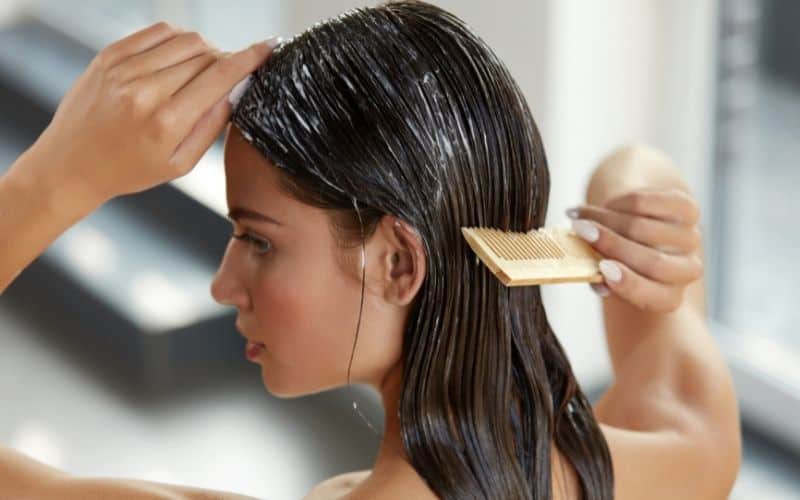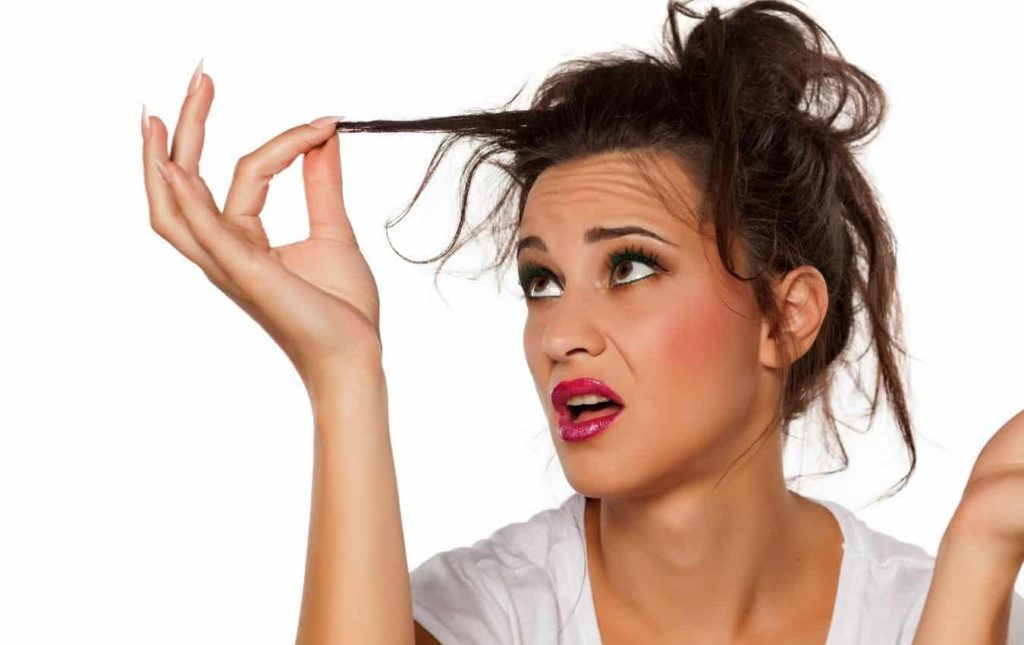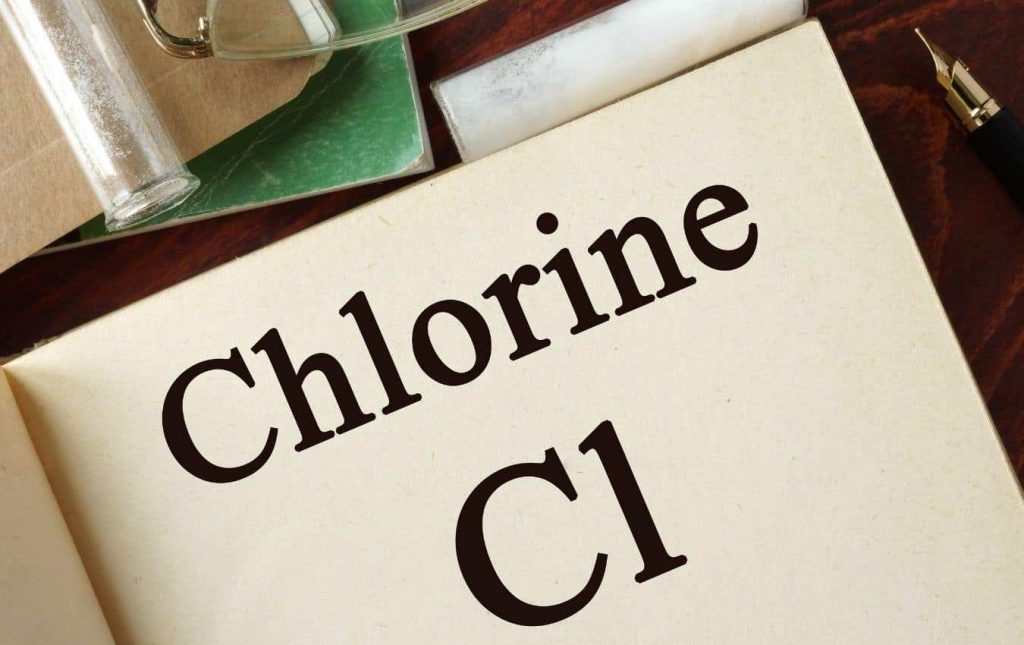Suddenly your hair is dry, damaged, and green. What’s going on? Chlorine damage is a condition that occurs to your hair when you have been swimming in a chlorinated pool for a prolonged amount of time.
Learn how to treat this type of chlorine damage by switching up your showering habits and what products to use or avoid using on your hair after swimming or being exposed to those chemicals from the pool.
Repairing Chlorine Damaged Hair
Chlorine can be found in natural sources, but it is most commonly caused by the use of chlorine-based chemicals to disinfect our water supplies. Swimming pools are an obvious source of this type of chemical exposure. Although you might not think that washing your hair would expose your tresses to these damaging elements, they will build up and dry out the ends of your hair over time.
Who Is at Risk for Chlorine Damaged Hair?
Anyone can suffer from chlorine-damaged hair, but this condition is most common in swimmers. The more you swim, the greater chance you will have for your hair to become dry and brittle. This includes when you are swimming above ground (in a pool) or underwater (ocean, lake, etc.).

How to Treat Chlorine Damaged Hair At Home
1. Take a Short Shower
Normally, there is no need to take a quick shower when you get home from swimming in a chlorinated pool unless your skin or scalp is burning from the chemicals in the water. This type of post-swim abuse can cause even more problems for your hair because it strips away too much natural oil and makes it dryer than usual.
2. Use Cold Water Only
The coldest temperature that’s comfortable for you in the shower should be used to wash the chlorine out of your hair after swimming. Hot water causes excessive damage to the hair over time, so save this setting for when you’re truly suffering from an intense case of dry winter air or sunburned skin.
3. Use a Mild Clarifying Shampoo
You might be tempted to reach for the most moisturizing shampoo you have on hand, but don’t! These can often contain sodium chloride or other harsh chemicals that will actually damage your hair further. Instead, choose a gentle clarifying shampoo that is free of these ingredients.
More: BEST WAIST TRAINER FOR WOMEN
4. Rinse Thoroughly
Be sure to rinse your hair several times after applying the shampoo so that every last bit of chlorine comes out with each sweep. The more thorough you are about removing this chemical from your tresses, the healthier they’ll be overall.
5. Apply Conditioner Only to Ends
Apply conditioner only to the very tips of your strands, so it doesn’t get trapped in dryness at the roots and worsen the problem.
6. Rinse Out Conditioner Thoroughly
Rinse out the conditioner using the same method as with your shampoo so that every last molecule of it is removed from your hair. Leaving any behind will cause more damage than good.
7. Use a Protein Treatment
Try using a protein treatment to restore balance and strength to the hair that you damaged with chlorine. These treatments should be applied only once every 2-3 weeks for your locks to remain healthy. These protein treatments can be found at any beauty supply store or department store.

More: BRUSH OFF THE BAD WITH THESE MAKEUP BRUSHES
How to Prevent Chlorine-Damaged Hair
1. Limit Your Time in the Pool
While swimming is a wonderful form of exercise and recreation, too much exposure to chlorine will damage your hair over time. Try limiting yourself to 30-45 minutes in the water when you go for a swim so that you don’t experience too much exposure.
2. Wear a Swim Cap & Hair Covering
Swim caps and hair coverings protect your hair from harmful chemicals when they’re submerged underwater for long periods of time. This protective gear can also help keep your strands dry when you’re exercising or at the gym, which is essential for not only preventing chlorine damage but other types of damage as well, such as split ends or heat.
3. Shampoo Right After Swimming
When you get home from a long day in the pool or at the beach, shampoo your hair right away to remove any salt that has been trapped in your locks throughout the day. This extra step is one of the best ways to prevent chlorine damage because it prevents chemicals from being exposed to your hair for too long.
4. Keep Hair Hydrated
In terms of how often to condition your hair, every other time you shampoo should suffice. If you have dry ends and frizzy strands, humectants can be added into the mix to hydrate dry areas and fight humidity.
5. Shampoo Less Often
Shampooing promotes oil production, which causes natural oils to build upon your scalp and contribute further towards dry hair. Be sure to shampoo only every 2-3 days to avoid this accumulation of oil.
Chlorine Facts & Myths

There is no such thing as chlorine-damaged hair
Harmful chemicals like chlorine and salt damage the hair, not chlorine itself.
Shampooing reduces but does not completely rid the body of chlorine
Swimming in chlorinated pools constantly exposes the mineral sodium chloride to your locks, so it’s still there even after you shampoo those strands several times over. This means that conditioners should still be used as well as they help prevent the chemical from locking onto your tresses.
Chlorine is not the only chemical that can cause damage to your hair
Salt and other chemicals found in public pools often make their way into your locks as well.
Natural sea salt does not contain chlorine
Sea salt contains sodium chloride, which is the same mineral that’s left behind after you rinse out that harsh pool water from your hair. This means that there’s no reason why you shouldn’t be able to swim without sunscreen or shampoo afterward, just as long as you’re using a gentle clarifying shampoo and conditioner afterward, so the natural sodium chloride doesn’t dry out your strands.
You should use “swimmer’s shampoo” before swimming to protect your hair
- [Elite Swim-Specific Formula with Hard Water Protection] TRIHARD Swimmers Shampoo goes beyond basic cleansing. It expertly eliminates chlorine and odors after your swim, meticulously extracting residual chlorine from the scalp. Indulge in the luxury of hydration, repair, and restored hair texture, tailored for the discerning swimmer.
- [Dermatologically Endorsed Nourishment] Our shampoo is a fusion of nature's best - 100% natural Red Algae and Dead Sea minerals, complemented by select botanicals. Enriched with Argan Oil and Shea Butter, it offers deep hydration and nourishment, ensuring your hair and scalp receive the utmost care.
- [Commitment to Eco-Friendly Elegance] Embodying the spirit of water and outdoor enthusiasts, TRIHARD presents its high-quality, soft-touch packaging made from 80% recycled plastic. We take pride in being the pioneering swim personal care brand that combines eco-consciousness with luxury.
- [Natural Ingredients for Conscious Care] In our quest for excellence, TRIHARD products shun SLS, parabens, alcohol, and GMOs. Our commitment is to clean, conscious hair care, designed to respect both your health and the environment.
- [Championed by the Best in Aquatics] TRIHARD is not just a shampoo; it's the choice of champions. Celebrated by Olympic icons like Lucy Charles, Kira Toussaint, and Lois Toulson, and embraced by professional Water Polo and Synchronized Swimming teams, it's the preferred brand for athletes and enthusiasts alike. Whether you're a competitive swimmer, a supportive parent, or a pool aficionado, TRIHARD ensures your hair remains in peak condition.
These shampoos typically contain sodium chloride rather than the harsher sodium laureth sulfate found in clarifying shampoos, which are better at stripping chlorine from your hair.
Chlorine is not necessary for public pools
This often-overlooked tidbit of information means that chlorine isn’t even an ingredient added to some public pools. You may still want to take steps to protect your locks before diving into a pool, but you don’t have to worry about swimming with dry, damaged strands.
Natural sea salt is better at closing the cuticle layer of the hair shaft
Sodium chloride has the same crystalline structure as table salt, which means that it’s more likely to adhere to wet surfaces like hair or skin than natural sea salt. This can make it slightly more difficult to rinse your hair after swimming in the pool. However, chlorine itself is too busy breaking up into ions that it can’t attach itself to hair or skin.
Swimming with a cap helps protect your hair from harmful chemicals
Swim caps protect your strands from pollutants, whether they’re found in drinking water or added to pool water due to excessive sunscreen application, sweat, or other chemical residues on the body. So while you may not be able to prevent the build-up of chlorine within your locks, swim caps are great at protecting your strands from any dirt, grime, and chemicals that may be hiding out in the water.
Chlorine isn’t just present in swimming pools but also in your tap water at home. The harsh chemicals from chlorine and its derivatives not only damage the hair but also irritate the skin.

More: CONCEALER 101 – GUIDE & HACKS
Frequently Asked Questions
How do I know if my hair is chlorine damaged?
For most people, the easiest way to tell if there’s chlorine damage is by running your fingers through your hair. If it feels dry and brittle, it’s a sign that the hair has been chemically damaged due to exposure to chlorine and its derivatives. Even just one time in a pool can be enough to leave behind some serious damage.
Do swim caps protect hair against chlorine?
Swim caps are great, but they typically only protect the hair near the scalp. If you have longer locks with chlorine damage, you’ll probably want to consider covering them up with a swim cap to keep them from drying out.
How often should I use shampoo to get rid of chlorine?
Since saltwater does not contain chlorine, it’s less likely that your hair will experience any dryness or brittleness after swimming in natural waters. You can feel free to forego heavy-duty clarifying shampoos after swimming in the ocean if you rinse your hair thoroughly afterward. This is why it’s also best to take advantage of vinegar rinses immediately after swimming in chlorinated pools because these acidic liquids help break down the chemicals within the water.
Can you use shampoo with natural sea salt instead of regular shampoo that contains sodium laureth sulfate?
Swimming in natural waters is a great way to take advantage of the benefits of sea salt without having to worry about all of the chlorine derivative chemicals that can dry out your strands. The sodium chloride found in seawater helps boost moisture retention. It closes up hair cuticles after exposure to chlorine, so there’s no need for a big shampooing afterward.
Is it safe for me to swim in chlorinated pools if I’m using conditioner and moisturizers?
Having to choose between chlorine or oil treatments may seem like a difficult decision, but over time using conditioners and moisturizers can actually make your hair more vulnerable to chlorine damage. The chemicals found in cosmetic products are often too heavy for the hair, so avoid them if you have longer locks. It makes it easier for water to seep inside the cuticle scales.
Does saltwater help reduce frizziness?
The answer is yes! Saltwater helps close up your cuticles, which means that it’s less likely for drops of water to enter into your hair. This creates a barrier effect that reduces frizz, tangles and attracts humidity, making it great for natural hairstyles.
Can chlorine turn my hair green?
It can. Swimmers often use green hair dye to help reduce the effects of chlorine damage. Still, commercial products that are designed for this might not be necessary if you rinse your hair thoroughly after swimming in chlorinated pools. After washing out the chemicals, simply towel dry the hair and apply some extra conditioner to areas where there’s still residue left behind before rinsing it out again.
Can chlorine cause hair loss?
There’s a possibility. The harsh chemicals from chlorine and its derivatives can attack the hair shaft making it easier to break off. Although this doesn’t happen frequently, it can be triggered by over-exposure to chlorine during swimming, so take the necessary precautions before jumping in any big bodies of water. In addition to covering your hair with a swim cap, you should also try using a leave-in conditioner that prevents hair from being exposed to chlorinated water for too long. Or, if you’re worried about losing strands after swimming, stick with natural bodies of water that don’t contain high levels of chlorine.
Does chlorine damage natural hair?
The answer is yes! It’s important to protect natural hairstyles with conditioning treatments that help reduce some of the chlorine’s harmful effects on the scalp and hair. Commercial products are often a better option than homemade remedies because they’re specifically tailored for swimmers.
What should I do after swimming in a pool?
Take the necessary precautions to rinse your hair after swimming in chlorinated pools. If you do this, it will help remove any leftover chemicals on the surface of the strands before they have a chance to cause heavy damage. Even though chlorine is found in all types of water, pools typically contain higher levels than other sources, making it more likely for your hair to experience dryness and brittleness.
What are the risks of swimming with chlorine?
Swimming in chlorinated pools can cause damage to your hair, but this is less likely if you reduce the risk of over-exposure. Allocate a window of time that’s between 30 minutes and an hour after swimming before you hop in the shower to wash out any chemicals left behind from the water. In addition, avoid any specialty products that contain harsh chemicals because they’re often too heavy for shorter hairstyles.
Does chlorine damage hair permanently?
It depends on the severity of the exposure. If you don’t take precautions before swimming, it can cause permanent hair loss along with discoloration and damage. Since pools contain high chemical concentrations, swimmers might not be able to rinse it all off after jumping in. As a result, this increases the likelihood of serious harm occurring.
What happens when chlorine mixes with sun exposure?
Chlorine interacts with sunlight, causing damage that’s similar to tanning under the sun. The combination of chemicals can burn the scalp and patches of strands, leaving behind brassy tones along with dryness and frizz. This is why it’s important to make sure your hair is completely rinsed after swimming in pools to reduce the risk of long-term damage.
Conclusion
While chlorine does offer great benefits to swimmers, it’s important to be aware of the potential damage its chemicals can cause. Washing your hair with cold water, using a gentle clarifying shampoo, and applying mild conditioner only to the tips will ensure that your locks remain healthy.
Last update on 2024-04-05 / Affiliate links / Images from Amazon Product Advertising API
Table of Contents
